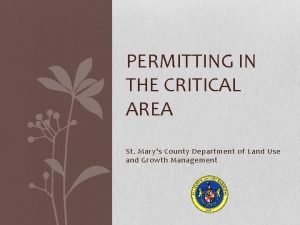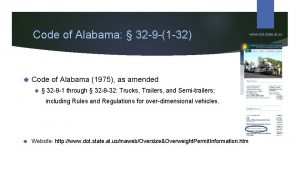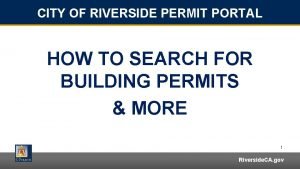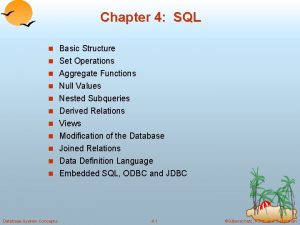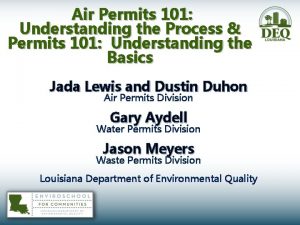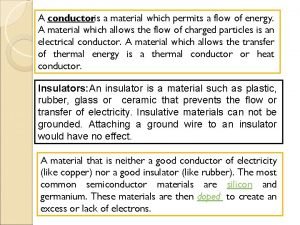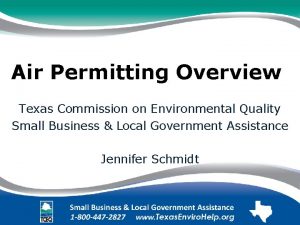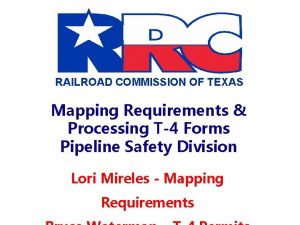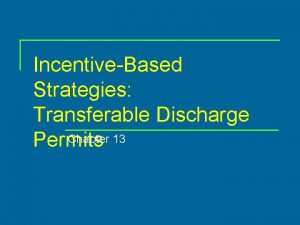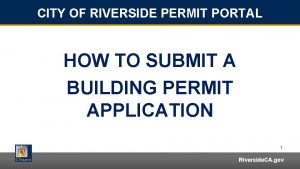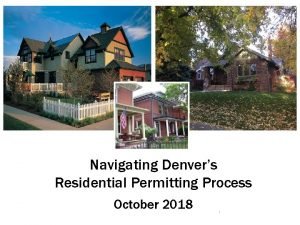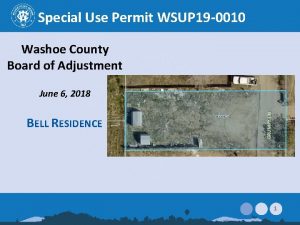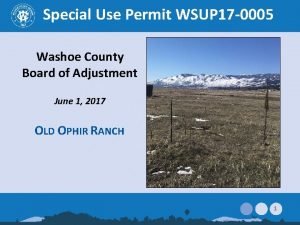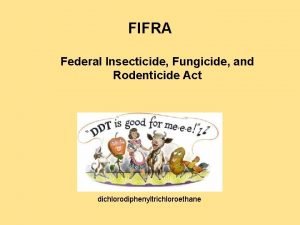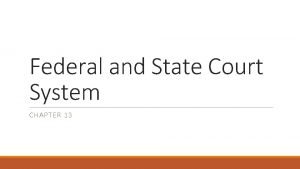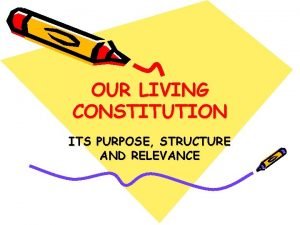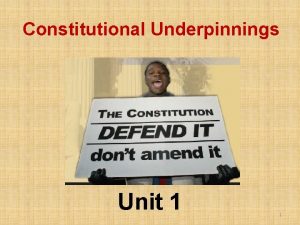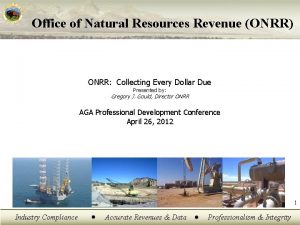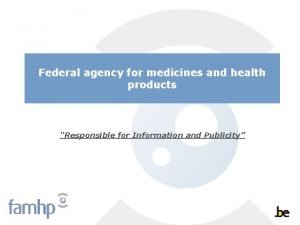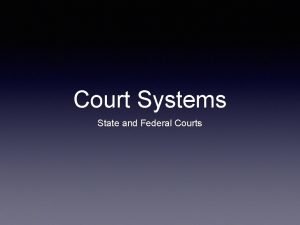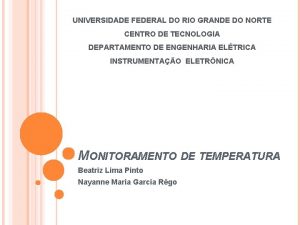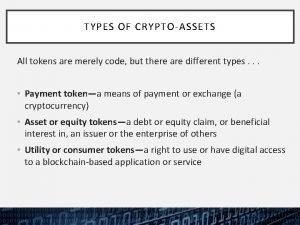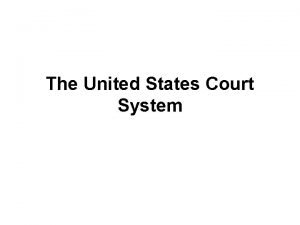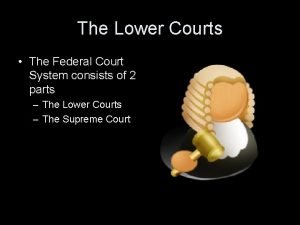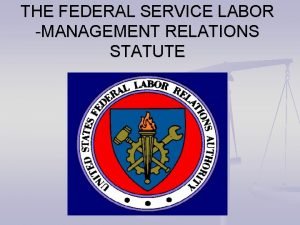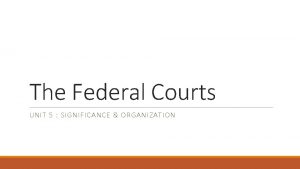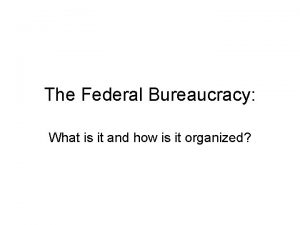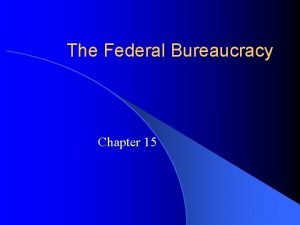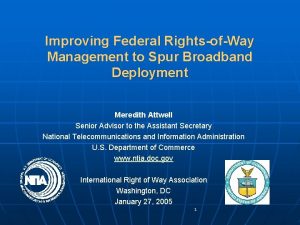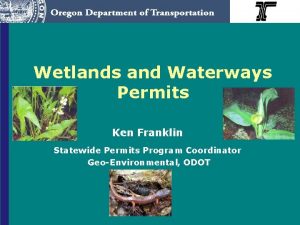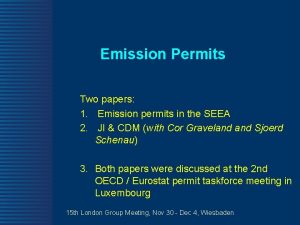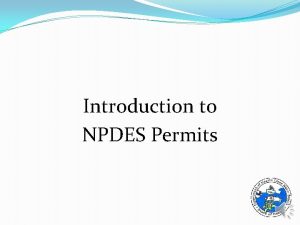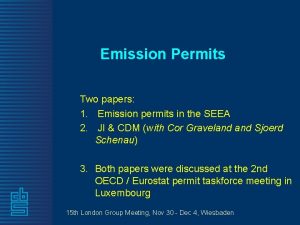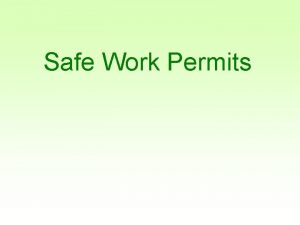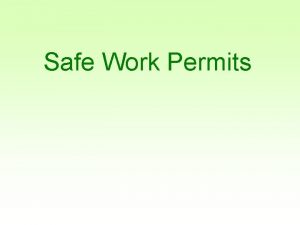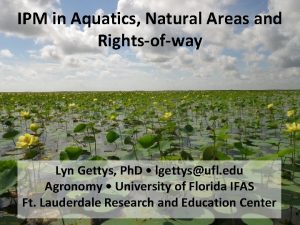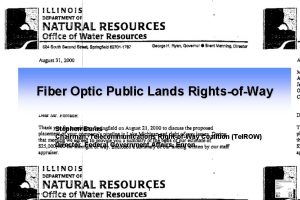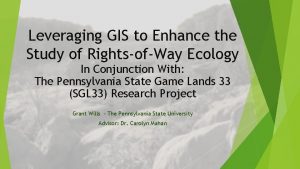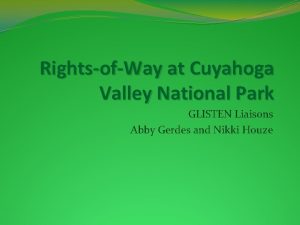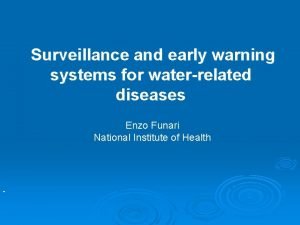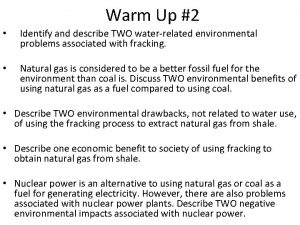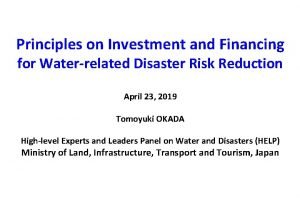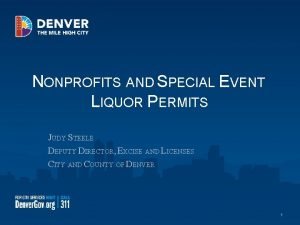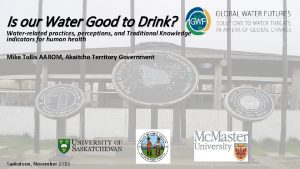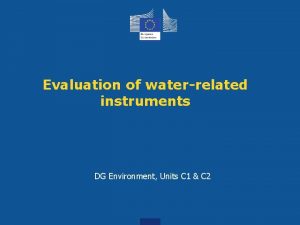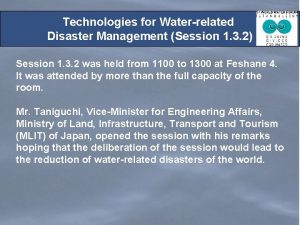WaterRelated RightsofWay and Special Use Permits on Federal











































- Slides: 43

Water-Related Rights-of-Way and Special Use Permits on Federal Lands Roy Smith Water Rights Specialist BLM Colorado and BLM Utah

Why do we discuss authorization of water facilities on federal lands in a water rights course? � Proposed developments can have significant impacts on federal water rights and waterdependent resources. � Federal agencies should be an effective partner with the state in reacting to and guiding proposed water development. � Federal agencies should engage in the water rights process when new facilities are proposed. 10/26/2016 2

Module Objectives: Given a proposed water diversion and conveyance facility on federal lands, students will be able to: � determine the legal authority and processes that should be used to evaluate the facility and make an authorization decision � identify the general types of operational terms and conditions that may be appropriate, if the facility is authorized � Identify how federal agencies should participate in the water rights process for a proposed facility 10/26/2016 3

What types of facilities are you likely to encounter? �Ditches, canal, laterals �Pipelines, flumes, siphons �Diversion dams, headgates, pump stations �Dams, spillways, inundation �Livestock ponds, fish ponds, settling ponds, recharge pits, stormwater reservoirs �Spring developments, storage tanks, troughs 10/26/2016 4

What types of facilities are you likely to encounter? �Wells: production, domestic, livestock, injection, monitor �Infiltration galleries in streambeds �Measurement infrastructure – stream gages, flumes, stage rods, flow meters �Related infrastructure – roads, electric lines, turbines, maintenance facilities 10/26/2016 5

Land Use Authorizations For Water-Related Facilities �First, PROCESS. . . What processes should we use ? With whom should we coordinate? What do we say in the water rights process? �Then, SUBSTANCE. . . What issues should we analyze? How do we make a decision to approve or deny? What terms and conditions should we use in a land use authorization? 10/26/2016 6

This presentation focuses only on new land use authorizations in Alaska. • In the Lower 48 states, many water facilities operate under pre-Federal Land Policy and Management Act (pre-FLPMA) Rights-Of-Way and Special Use Permits. • These authorization have an entirely different legal basis and management approach. 10/26/2016 7

Processing land use applications for water-related facilities What comes first? Land use authorization or water rights process? 10/26/2016 8

The land use authorization process and water rights process should proceed simultaneously. � Carefully review all water rights applications for activities that could affect federal lands. Don’t assume state will notify you, because state must rely on applicant-supplied info. � Encourage applicants to consult with both feds and state BEFORE water right and land use applications are filed. 10/26/2016 9

The land use authorization process and water rights process should proceed simultaneously. � Protest the water right application if the federal agency has not authorized or cannot authorize the facility. � Don’t issue final land use authorization unless you are confident that the water right will granted. Consult with AK DNR on application status. 10/26/2016 10

What points can I make in a protest? �Status of land use authorization �Laws, regs, and plans that will govern authorization process �Federal water rights that could be injured if application approved �Potential impacts and injury to federal water rights and to waterdependent resources on federal lands 10/26/2016 11

What points can I make in a protest? �Data that the state can use during evaluation of the water right application �Delay approval of application until we are confident that federal land use authorization can be obtained OR include term/condition that right will terminate if federal land use authorization is denied 10/26/2016 12

Processing land use applications: how do I resolve water rights issues? �NEVER issue authorization: - without investigating water rights situation first - when any federal agency water rights protest is unresolved �NEVER assume authorization needs to be issued just because applicant already has a permit or water right. �REMIND applicant that federal land use approval is a DISCRETIONARY ACTION. 10/26/2016 Shelby says: Get out on the ground and investigate the water rights situation! 13

Processing land use applications: how do I resolve water rights issues? �Instead, proceed through land use authorization and NEPA process to identify whether facility can be authorized without significant impact to federal resources and water rights. �Notify state of analysis results and/or decision, including terms and conditions regarding location, amount, and timing of water use. 10/26/2016 14

Resolving water rights issues: who should own water rights on federal lands? In U. S. ownership when: �When water is used by public or agency for federal land management purposes (e. g visitor facilities, wildlife water facilities, etc. ) �When permittee, contractor, or other public land users consume water for federal land management purposes (e. g. concessions, forestry management contract, etc. ) 10/26/2016 In private ownership when: �Federal agency authorizes permanent facility on federal lands for a usage location that occurs off of federal lands (e. g. municipal water supply) �For time-limited energy, mineral, and commodity development and water use ceases when authorization ends. Rights should be forfeited or assigned to U. S. upon termination. 15

Resolving water rights issues: Does state deal with all water use impacts? �States typically have authority only for water allocation, not for addressing environmental impacts from water use. �Federal agencies have authority and obligation to conduct impact analysis, avoid/minimize impacts, and make decisions that provide for sustainable resource use. �Federal agencies are obligated to address impacts associated with water usage, even if decisions result in reduced yields for approved water rights. 10/26/2016 16

What processes do we use to authorize water-related facilities? Fish and Wildlife Service: National Park Service: �Application for Special Use �Application letter pursuant to Permit, and/or National Wildlife Refuge System Act �Application for Transportation and Utility Systems on Federal �Letter requirements set forth in Lands (SF-299) 50 CFR Subpart B, Section 29 10/26/2016 17

What processes do we use to authorize water-related facilities? BLM & USFS Multiple Use Methods �Pre-Federal Land Policy and Management Act Rights-of. Way (pre-1976) �Federal Land Policy and Management Act Authorizations - Rights-of-Way (BLM) - Special Use Permits (USFS) 10/26/2016 18

What methods can we use to authorize water-related facilities? BLM & USFS: Program-Specific Methods �Plans of Operation for Minerals/Energy Leases – oil, gas, coal, geothermal, etc. �Recreations Leases (BLM) and Permits (USFS) – ski areas, concessions, recreational residences, etc. �Forestry Contracts – special stipulations 10/26/2016 19

What methods can we use to authorize water-related facilities? ANILCA processes for utility systems in Conservation System Units (Title XI) � Utility systems include any water conveyance facility � Joint applications to all federal agencies affected � Joint EIS by federal agencies, if required � Statutory deadlines for a decision 10/26/2016 20

ANILCA Process Requirements 10/26/2016 Federal agencies must analyze: �Need and economic feasibility �Alternative routes through non-CSU lands �Impacts on local economics, fish and wildlife, and traditional rural lifestyles �Impacts on purpose of the CSU �Impacts on public values versus long-term public 21 benefits

Processing ROW/SUP applications: What analysis process should I use? Federal agencies must: �Collect data to justify terms and conditions �Provide documentation of reasoned analysis �Reference laws/regs/policies leading to decision �Consider mitigation measures proposed by applicant 10/26/2016 Appeal decisions assume that federal agencies follow procedures correctly. The appealing party must prove that the federal process or analysis was in error. Federal agencies can reject (not process) applications if: �Proposed use is inconsistent with law/regs/land use plans �Do not comply with screening criteria found in regulations 22

What goes into a “reasoned analysis”? 1. Questions about the water source: �Is access to the water source available on private lands? �Are other water sources available? �Would the proposed use injure existing uses from this source? �Would the water source itself be damaged? 10/26/2016 2. Questions about the resource: What impact on riparian, wetlands, wildlife, water quality, erosion, cultural, T&E species, etc? 23

“Reasoned Analysis” Example �Are there other water sources for livestock? �Will the aquifer be damaged? Are aquifer levels stable? �Can well construction techniques avoid impacts? �Will fens be impacted? �Will water be available for wildlife use? 10/26/2016 24

IBLA Cases For Process Guidance � Grant Hacking (Utah) �Water needed for public purposes � King’s Meadow Ranches (Utah) � Destruction of riparian habitat and erosion � Vogel (Oregon) � BLM must have record to support decisions � Philp (Oregon) � Lederhause (Colorado) 25 �BLM fails to supply supporting rationale �No obligation to approve structures that could be built on private lands 10/26/2016

Land Use Authorizations For Water-Related Facilities �First, PROCESS. . . What processes should we use ? With whom should we coordinate? What do we say in the water rights process? �Then, SUBSTANCE. . . What issues should we analyze? How do we make a decision to approve or deny? What terms and conditions should we use in a land use authorization? 10/26/2016 26

The Substance: Standard for Approval/Denial • Consistent with the mission of the Forest Service to manage lands and resources in a manner that will best meet the present and future needs of the American people, taking into account the needs of future generations for renewable and nonrenewable resources. • The proposed use cannot be reasonably accommodated on non National Forest System lands. • Does not authorize use of National Forest System lands solely because it affords the application a lower cost or less restrictive when compared with non NFS lands. 10/26/2016 27

The Substance: Standard for Approval/Denial • Consistent with the purposes for which BLM manages public lands (multiple use) • Consistent with public interest • Protects natural resources • Prevents unnecessary and undue degradation to public lands 10/26/2016 28

The Substance: Standard for Approval/Denial • Contributes to the achievement of the National Wildlife Refuge purposes • Does not materially interfere with or detract from the mission the National Wildlife Refuge. This standard is known as “compatible use. ” • Will not unduly interfere with the management, administration, or disposal by the United States of the 10/26/2016 affected lands. 29

The Substance: Standard for Approval/Denial • Does not jeopardize or unduly interfere with the primary natural or historic resources of the area involved • Provides public services within the immediate vicinity of the park • There are no reasonable alternatives to acquire the water 10/26/2016 • Will not contribute to future dependency on park 30

The Substance: Terms and Conditions 10/26/2016 31

Authority for Terms & Conditions Federal Land Policy Endangered Species Act: and Management “every federal agency shall. . ensure that any action Act: authorized … is not likely to “minimize damage to scenic and aesthetic values and fish and wildlife habitat or otherwise protect the environment” 10/26/2016 jeopardize the continued existence of any endangered or threatened species or result in destruction or adverse modification of habitat of such species …” 32

Authority for Terms & Conditions National Environmental Policy Act: Utah Power and Light Co. v. U. S. 243 U. S. 389 Requires best available science to analyze, minimize, and avoid environmental impacts Access to state water rights on federal lands occurs under FEDERAL LAW. 10/26/2016 33

Agency Guidance - Terms & Conditions USFS Water Uses and Development Manual Section 2541. 35: BLM Water Rights Manual 7250 - Section 1. 5. B. 6: Include stipulations in the authorizing documents to ensure the quantities of water needed to fulfill purposes of the National Forest and for environmental needs will be maintained instream. In all land use authorizations, the BLM shall include terms and conditions to protect water rights and water uses on public lands. 10/26/2016 34

Agency Guidance - Terms & Conditions 50 CFR 29. 21 -4 (Fish and Wildlife Service regs): An applicant, by accepting an easement or permit agrees to such terms and conditions as may be prescribed by the Regional Director in the granting document. 10/26/2016 NPS Director’s Order #53, Special Park Uses – Section 8 To protect NPS interests, the Superintendent shall incorporate appropriate conditions into all special park use permits. 35

Federal management objectives for water-related ROWs/SUPs �Predictability of operations and impacts �Minimization and avoidance of impacts �Applicants remain within authorized purposes �Authorize practices, not just structures �RESULT: Facility operation plans; increased reporting 10/26/2016 36

Meeting federal management objectives with terms/conditions Example General Stipulations: �Applicant will not sell, lease, or use water for any other than stated purposes �Applicant may not change type, place, or volume of use without consent �Usage must include water conservation measures �Modify water facility to support other values, such as wildlife and wetlands 10/26/2016 37

ROWs/SUPs in hydrologic systems where little data exists Example Stipulations: �Applicant collects baseline data impacts analysis �Applicant pays for studies to ID relationships between groundwater basin and springs, streams, and adjacent basins �Applicant agrees to long-term monitoring. �Applicant agrees to adaptive management and project modification if unexpected impacts occur 10/26/2016 38

Meeting federal management objectives with terms/conditions 10/26/2016 Example stipulations for surface water facilities: �Limit volume/rate diverted �Limit diversion season �Design structures to prevent fish entrainment and allow fish passage �Move facility locations to avoid sensitive habitats �Use alternative sources of water (e. g. wells, water stored in reservoirs) during sensitive low 39 flow periods

Addressing new environmental drivers with terms/conditions Example stipulations for groundwater facilities: �Submit copies of all permits and test results �Require well pump test before authorizing project �Cease pumping during critical aquifer periods �Monitor water quality for unexpected changes �Install meter and submit annual report on pump rates and pump volumes 10/26/2016 40

Water Facility Operation Plans: Certainty and Communication �Diversions - rates, dates, and measurement procedures �Access – routes, equipment, and snow removal �Repairs – routine, major, catastrophic �Maintenance – timing, tools �Ditch problems – washouts, downcutting, erosion �Instream work – diversion dams, vegetation control What happens when a flood destroys facility? 10/26/2016 41

Water Facility Operation Plans: Advantages �Can include a schedule for regular revision and updates �Revision to an operating plan doesn’t require amending the right-of-way grant or special use permit �Can and should be negotiated before the SUP or ROW is offered What happens when a flood destroys facility? 10/26/2016 42

Notebook References 10/26/2016 43
 St mary's county critical area permits
St mary's county critical area permits Computational pharmacology
Computational pharmacology Alabama overweight permits
Alabama overweight permits City of riverside permit portal
City of riverside permit portal Basic structure of sql
Basic structure of sql Air permits 101
Air permits 101 The material that permits the flow of electricity
The material that permits the flow of electricity Texas air quality permits
Texas air quality permits Texas railroad commission pipeline permits
Texas railroad commission pipeline permits Modot motor carrier express
Modot motor carrier express Types of transferable discharge permits
Types of transferable discharge permits Riverside county permit portal
Riverside county permit portal Private pilot limitations and privileges
Private pilot limitations and privileges Denver quick permits
Denver quick permits Apras permits
Apras permits The logical view of data is
The logical view of data is Unit 2 lesson 5 exploring angles
Unit 2 lesson 5 exploring angles Washoe county special use permit
Washoe county special use permit Washoe county special use permit
Washoe county special use permit Yesterday
Yesterday Rotenone
Rotenone Lower court
Lower court State and federal constitutions
State and federal constitutions What are the three levels of government
What are the three levels of government State and federal constitutions
State and federal constitutions Fed rothschild
Fed rothschild The fed today video questions answers
The fed today video questions answers Onrr reporting and compliance
Onrr reporting and compliance Federal agency for medicines and health products
Federal agency for medicines and health products Federal and state court systems
Federal and state court systems Universidade federal do rio grande do norte
Universidade federal do rio grande do norte Universidade federal do rio grande do norte
Universidade federal do rio grande do norte Gsa vehicle leasing guide
Gsa vehicle leasing guide Federal reserve jurisdiction
Federal reserve jurisdiction U.s. circuit court
U.s. circuit court Federal court system structure
Federal court system structure Federal service labor-management relations statute
Federal service labor-management relations statute Who created the federal reserve
Who created the federal reserve Structure of the federal reserve
Structure of the federal reserve Federal court structure
Federal court structure Federal bureaucracy definition
Federal bureaucracy definition Chapter 15 the federal bureaucracy
Chapter 15 the federal bureaucracy Sujetos colectivos ley federal del trabajo
Sujetos colectivos ley federal del trabajo Federal question jurisdiction
Federal question jurisdiction
